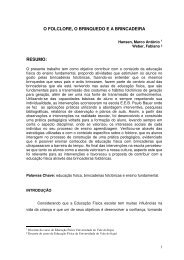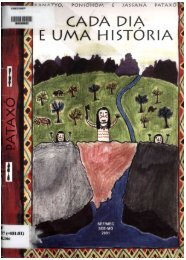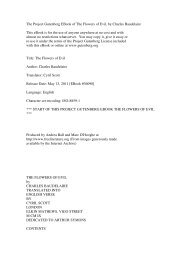A History of English Literature
A History of English Literature
A History of English Literature
Create successful ePaper yourself
Turn your PDF publications into a flip-book with our unique Google optimized e-Paper software.
emote spots down almost to the present time, sometimes took the form <strong>of</strong><br />
energetic dances (Morris dances, they came to be called, through confusion<br />
with Moorish performances <strong>of</strong> the same general nature). Others <strong>of</strong> them,<br />
however, exhibited in the midst <strong>of</strong> much rough-and-tumble fighting and<br />
buffoonery, a slight thread <strong>of</strong> dramatic action. Their characters gradually<br />
came to be a conventional set, partly famous figures <strong>of</strong> popular tradition,<br />
such as St. George, Robin Hood, Maid Marian, and the Green Dragon. Other<br />
<strong>of</strong>fshoots <strong>of</strong> the folk-play were the 'mummings' and 'disguisings,'<br />
collective names for many forms <strong>of</strong> processions, shows, and other<br />
entertainments, such as, among the upper classes, that precursor <strong>of</strong> the<br />
Elizabethan Mask in which a group <strong>of</strong> persons in disguise, invited or<br />
uninvited, attended a formal dancing party. In the later part <strong>of</strong> the Middle<br />
Ages, also, there were the secular pageants, spectacular displays (rather<br />
different from those <strong>of</strong> the twentieth century) given on such occasions as<br />
when a king or other person <strong>of</strong> high rank made formal entry into a town.<br />
They consisted <strong>of</strong> an elaborate scenic background set up near the city gate<br />
or on the street, with figures from allegorical or traditional history who<br />
engaged in some pantomime or declamation, but with very little dramatic<br />
dialog, or none.<br />
TROPES, LITURGICAL PLAYS, AND MYSTERY PLAYS. But all these forms, though<br />
they were not altogether without later influence, were very minor affairs,<br />
and the real drama <strong>of</strong> the Middle Ages grew up, without design and by the<br />
mere nature <strong>of</strong> things, from the regular services <strong>of</strong> the Church.<br />
We must try in the first place to realize clearly the conditions under<br />
which the church service, the mass, was conducted during all the medieval<br />
centuries. We should picture to ourselves congregations <strong>of</strong> persons for the<br />
most part grossly ignorant, <strong>of</strong> unquestioning though very superficial faith,<br />
and <strong>of</strong> emotions easily aroused to fever heat. Of the Latin words <strong>of</strong> the<br />
service they understood nothing; and <strong>of</strong> the Bible story they had only a<br />
very general impression. It was necessary, therefore, that the service<br />
should be given a strongly spectacular and emotional character, and to this<br />
end no effort was spared. The great cathedrals and churches were much the<br />
finest buildings <strong>of</strong> the time, spacious with l<strong>of</strong>ty pillars and shadowy<br />
recesses, rich in sculptured stone and in painted windows that cast on the<br />
walls and pavements s<strong>of</strong>t and glowing patterns <strong>of</strong> many colors and shifting<br />
forms. The service itself was in great part musical, the confident notes <strong>of</strong><br />
the full choir joining with the resonant organ-tones; and after all the<br />
rest the richly robed priests and ministrants passed along the aisles in<br />
stately processions enveloped in fragrant clouds <strong>of</strong> incense. That the eye<br />
if not the ear <strong>of</strong> the spectator, also, might catch some definite knowledge,<br />
the priests as they read the Bible stories sometimes displayed painted<br />
rolls which vividly pictured the principal events <strong>of</strong> the day's lesson.<br />
Still, however, a lack was strongly felt, and at last, accidentally and<br />
slowly, began the process <strong>of</strong> dramatizing the services. First, inevitably,<br />
to be so treated was the central incident <strong>of</strong> Christian faith, the story <strong>of</strong><br />
Christ's resurrection. The earliest steps were very simple. First, during<br />
the ceremonies on Good Friday, the day when Christ was crucified, the cross<br />
which stood all the year above the altar, bearing the Savior's figure, was<br />
taken down and laid beneath the altar, a dramatic symbol <strong>of</strong> the Death and<br />
Burial; and two days later, on 'the third day' <strong>of</strong> the Bible phraseology,<br />
that is on Easter Sunday, as the story <strong>of</strong> the Resurrection was chanted by<br />
the choir, the cross was uncovered and replaced, amid the rejoicings <strong>of</strong> the<br />
congregation. Next, and before the Norman Conquest, the Gospel dialog<br />
between the angel and the three Marys at the tomb <strong>of</strong> Christ came sometimes<br />
to be chanted by the choir in those responses which are called 'tropes':<br />
'Whom seek ye in the sepulcher, O Christians ?' 'Jesus <strong>of</strong> Nazareth the















